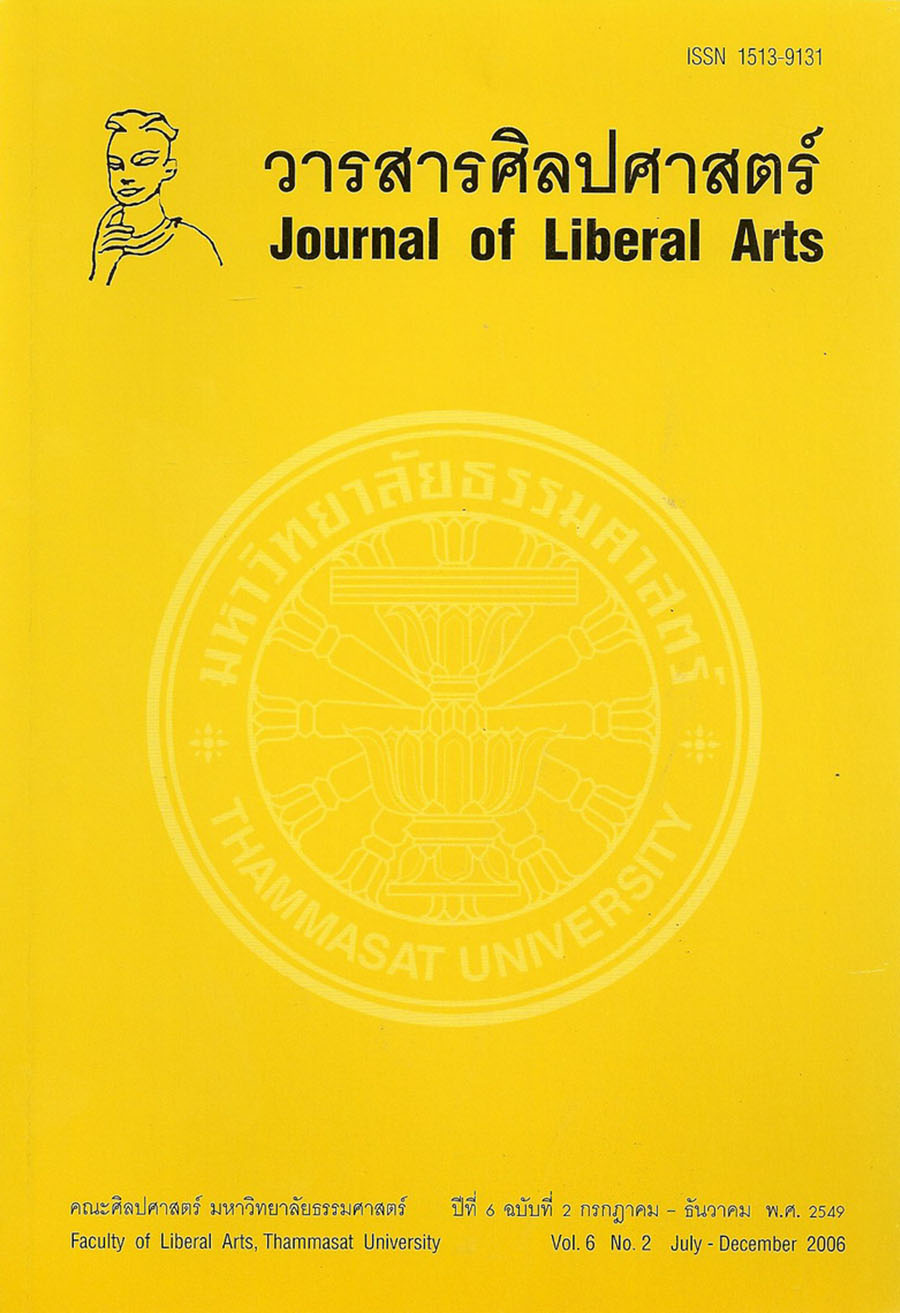การศึกษาการใช้ภาษาข้ามวัฒนธรรม: การวิเคราะห์ภาษาในหนังสือ
Main Article Content
บทคัดย่อ
งานวิจัยเรื่อง การศึกษาการใช้ภาษาข้ามวัฒนธรรม: การวิเคราะห์ภาษาในหนังสือ A Physician at the Court of Siam โดยนายแพทย์มัลคอล์ม สมิธ มีวัตถุประสงค์เพื่อศึกษากลวิธีการใช้ภาษาอังกฤษในการสื่อความหมายเกี่ยวกับวัฒนธรรมไทยในรัชสมัยพระบาทสมเด็จพระเจ้าอยู่หัวรัชกาลที่ 4 ถึงรัชกาลที่ 6 นอกจากนั้นยังได้รวบรวมคำศัพท์และสำนวนภาษาอังกฤษที่เกี่ยวกับวัฒนธรรมไทยอีกด้วย
กลวิธีที่ใช้สื่อสารข้ามวัฒนธรรมในหนังสือ A Physician at the Court of Siam มีดังนี้
1. การทับศัพท์ ใช้กับชื่อเฉพาะ, คน, สิ่งของ, และศัพท์ทางการแพทย์
2. ภาษาอังกฤษที่มีความหมายเหมือนกับความหมายในภาษาไทย ใช้กับชื่อเฉพาะ, คน, สัตว์, สิ่งของ, กิริยา การกระทำ, นามธรรม, พิธีกรรม/พระราชพิธี, อาคาร สถานที่, และศัพท์ทางการแพทย์
3. ภาษาอังกฤษที่มีความหมายใกล้เคียงกับภาษาไทย ใช้กับชื่อเฉพาะ, คน, สิ่งของ, กิริยา การกระทำ, นามธรรม, พิธีกรรม/พระราชพิธี, อาคาร สถานที่, และศัพท์ทางการแพทย์
4. คำแปลตรงกับภาษาไทย ใช้กับชื่อเฉพาะ และสิ่งของ
5. การอธิบาย (เป็นการใช้โครงสร้างภาษาขนาดสั้น เช่น วลี, อนุประโยคหรือประโยคสั้น ๆ 2-3 ประโยค) ใช้กับคน, กิริยา การกระทำ, พิธีกรรม/พระราชพิธี, อาคาร สถานที่ และศัพท์ทางการแพทย์
6. การบรรยาย (เป็นการให้รายละเอียด) ใช้กับคน, สิ่งของ, กิริยา การกระทำ, นามธรรม, พิธีกรรม/พระราชพิธี, อาคาร สถานที่, และศัพท์ทางการแพทย์
7. การเปรียบเทียบ (กับสิ่งที่มีอยู่ในวัฒนธรรมอังกฤษ) ใช้กับคน, สิ่งของ, กิริยา การกระทำ, นามธรรม, อาคาร สถานที่, และศัพท์ทางการแพทย์
8. ภาพประกอบ ใช้กับคน และอาคาร สถานที่
9. ตาราง ใช้ในการแสดงลำดับในราชวงศ์จักรี
This research entitled Cross-Cultural Studies of Language: An Analysis of Language in A Physician at the Court of Siam by Dr.Malcolm Smith aims to study the strategies used in the English language to narrate Thai culture during the reigns of King Rama IV to King Rama VI. A glossary of English words and expressions for Thai culture is another goal of the research.
The strategies for cross-cultural communication used in A Physician at the Court of Siam are as follows:
1. Transcription is used for Proper Names, Human-beings, Things, and Medical Terms.
2. Equivalence (English words or expressions having the same meanings in Thai) is used for Proper Names, Human-beings, Animals, Things, Performance, Concepts, Ceremonies, Places and Buildings, and Medical Terms.
3. Non-equivalence (English words or expression having meaning close to what exits in Thai culture, but not the same) is used for Proper Names, Human-beings, Things, Performance, Ceremonies, Place and Buildings, and Medical Terms.
4. Literal Translation is used for Proper Names and Things.
5. Explanation (explaining in phrases, clauses, or a few sentences) is used for Human-beings, Performance, Ceremonies, Places and Buildings, and Medical Terms.
6. Description (giving details to add more explanation) is used for Human-beings, Things, Performance, Concepts, Ceremonies, Places and Buildings, and Medical Terms.
7. Comparison (with what exists in English-speaking culture) is used for Human-beings, Things, Performance, Concepts, Places and Buildings, and Medical Terms.
8. Illustration is used for Human-beings and Places and Buildings.
9. A table is used to show the hierarchy of the House of Chakri.

